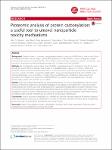Proteomic analysis of protein carbonylation: a useful tool to unravel nanoparticle toxicity mechanisms
Driessen, Marc D.
Mues, Sarah
Vennemann, Antje
Hellack, Bryan
Bannuscher, Anne
Vimalakanthan, Vishalini
Riebeling, Christian
Ossig, Rainer
Wiemann, Martin
Schnekenburger, Jürgen
Kuhlbusch, Thomas A. J.
Renard, Bernhard Y.
Luch, Andreas
Haase, Andrea
Background: Oxidative stress, a commonly used paradigm to explain nanoparticle (NP)-induced toxicity, results from an imbalance between reactive oxygen species (ROS) generation and detoxification. As one consequence, protein carbonyl levels may become enhanced. Thus, the qualitative and quantitative description of protein carbonylation may be used to characterize how biological systems respond to oxidative stress induced by NPs. Methods: We investigated a representative panel of 24 NPs including functionalized amorphous silica (6), zirconium dioxide (4), silver (4), titanium dioxide (3), zinc oxide (2), multiwalled carbon nanotubes (3), barium sulfate and boehmite. Surface reactivities of all NPs were studied in a cell-free system by electron spin resonance (ESR). NRK-52E cells were treated with all NPs, analyzed for viability (WST-1 assay) and intracellular ROS production (DCFDA assay). Carbonylated proteins were assessed by 1D and/or 2D immunoblotting and identified by matrix assisted laser desorption time-of-flight mass spectrometry (MALDI-TOF/TOF). In parallel, tissue homogenates from rat lungs intratracheally instilled with silver NPs were studied. Results: Eleven NPs induced elevated levels of carbonylated proteins. This was in good agreement with the surface reactivity of the NPs as obtained by ESR and the reduction in cell viability as assessed by WST-1 assay. By contrast, results obtained by DCFDA assay were deviating. Each NP induced an individual pattern of protein carbonyls on 2D immunoblots. Affected proteins comprised cytoskeletal components, proteins being involved in stress response, or cytoplasmic enzymes of central metabolic pathways such as glycolysis and gluconeogenesis. Furthermore, induction of carbonyls upon silver NP treatment was also verified in rat lung tissue homogenates. Conclusions: Analysis of protein carbonylation is a versatile and sensitive method to describe NP-induced oxidative stress and, therefore, can be used to identify NPs of concern. Furthermore, detailed information about compromised proteins may aid in classifying NPs according to their mode of action.
Dateien zu dieser Publikation
Keine Lizenzangabe

